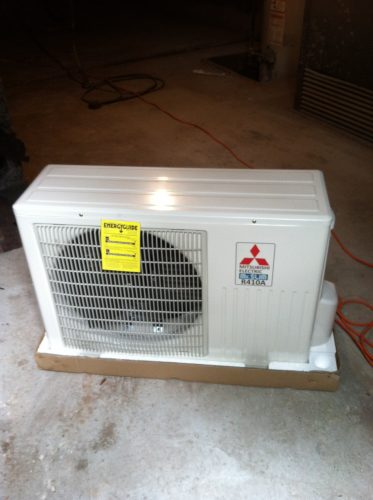Last week I wrote a blog post after I calculated the energy savings per year and the payback period for a Split AC/heat pump versus a Window AC. The results were interesting. It should me that the price differential between the two alternatives would only be around $47 a year. This would mean the payback period would be over 40 years! I sincerely hoped this was not true!
I published the post on Eco-Brooklyn’s website and Gennaro sent the link out to his circle of green building friends hoping to get some feedback. What we received back in a few short days was an overwhelming amount of feedback and recommendations.
The split AC/heat pump cost $2100 to cover the cost of the unit and installation. It has a 9000 Btu/h output and a 26 SEER rating. For this exercise I used the most energy efficient, Energy Star rated, and most purchased window AC unit at Sears that costs around $210. The unit has an output of 8000 Btu/h output and a 10.8 EER rating. I converted EER to SEER in the exercise below.
The group of green builders voiced their opinions and came to the conclusion that it was too difficult to determine specific solar and internal heat gains for this type of calculation. Also, there is an indeterminable amount of air leakage through window and wall sources. These provide large questionable variables when trying to determine which system to implement.
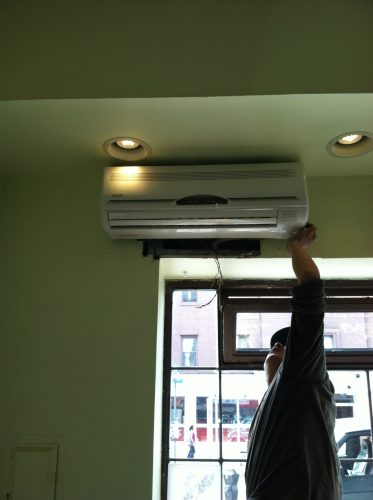
During the conversation on the thread I discovered that I had the wrong formula to determine the cooling load for the area using the different AC systems. In the original formula I divided the (Btu/h x cooling degree days x 24) by the change in average high and low within the month. I then divided that number by the SEER to get the total kWh needed for cooling.
I discovered that instead of dividing by the change in temperature within the month I had to divide by the design temperature difference which is the difference between the average outside temperature and the optimal energy you want inside. For this exercise I had to use 65 degrees Fahrenheit for the optimal indoor temperature because that is the temperature that the NREL (National Renewable Energy Laboratory) uses to determine cooling degree days. The average temperature in New York during the months of the cooling degree days (May-September) is 78.8 degrees Fahrenheit. Here is the new formula I used to compute the total kWh consumption per year for each system:
Cooling load = Btu/h x CDD x 24
1000 x SEER x design temp. difference
Instead of using the individual cooling degree days for each month I used the total cooling degree days in New York according to the NREL. With the new formula I re-computed all of my previous calculations to get the following results:
Split AC
Cooling load= 9000 Btu/h x 1096 CDD x 24 h/day = 659 kWh
1000 x 26 x 13.8
1059 kWh x .18 cents/kWh= $118.76 a year
Window AC
Cooling load= 8000 Btu/h x 1096 CDD x 24 h/day = 1059 kWh
1000 x 14.4 x 13.8
679 kWh x .18 cents/kWh = $190.62 a year
Payback period = ($2100 – $210) / $71 = 26 years
With the new formulas I discovered the payback period decreased from 40 years to 26 years. An improvement, but it is still not the best. But there is a discrepancy between the amount of energy consumed by the two different alternatives. On the market, there is no window AC that consumes 9000 Btu/h so I used the 8000 Btu/h alternative.
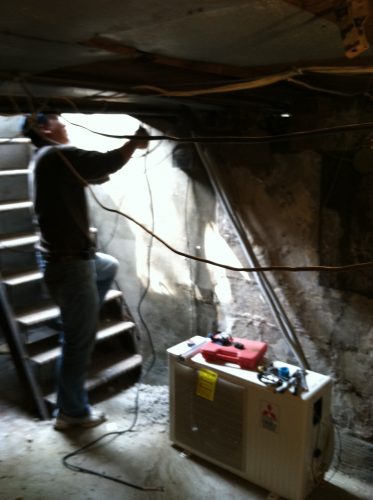
So then I decided to take the future into consideration. Because of the rapid advance of global warming we are now subject to a much hotter climate, which will result in the increased usage of air conditioners.
So now let’s use a hypothetical example that will probably become a reality in the years to come. I want to equate the cooling Btu/h equal to each other for the most realistic outcome. I will hold the type of split AC constant, but change the window AC to a hypothetical one with a cost of $250, a cooling load of 9000 Btu/h, and a SEER of 14.4.
Now, let’s assume that because of global warming the climate of New York City becomes like the climate of Washington DC. The amount of cooling degree days in New York will increase to 1317 and the average temperature will increase to 84 degrees Fahrenheit during the warm months. Here is what happened with the payback period between the two alternatives:
Split AC
Cooling load = 9000 Btu/h x 1317 CDD x 24 = 2399 kWh
1000 x 26 x 19
2399 kWh x .18 cents/kWh = $431 a year
Window AC
Cooling load = 9000 Btu/h x 1317 CCD x 24 = 4333 kWh
1000 x 14.4 x 19
4333 kWh xx .18 cents/kWh = $779 a year
Payback period = ($2100 – $250) / $348 = 5.31 years
Now, a payback period of 5 years is something to get very excited about. This means that currently in DC, the payback period for a split AC is only 5 years. Imagine if we go farther South: Richmond, Charlotte, Georgia, Miami?! It seems like the split AC should be the only option when compared to window AC’s. In the coming years, we will see split AC’s becoming more efficient while the temperature will continue to get warmer, making them a more viable option for the average consumer in New York.
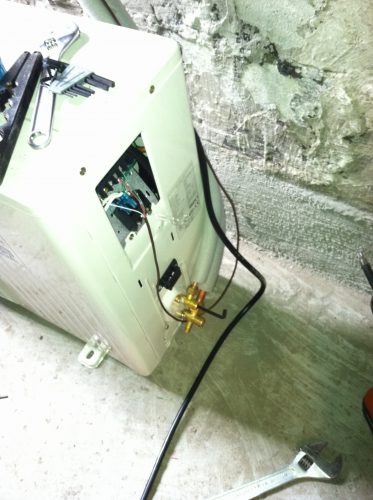
But as of right now this is not the case. 26 years for the initial calculated payback period is definitely quite a long time to wait. But there are definitely some discrepancies in my calculations and facts that would shorten this payback period. First of all, I do not calculate for any solar heat gains from windows or internal heat gains from people and electronic equipment. Also, I do not account for any air leakage from the building. Both of these factors will give off heat, requiring more air conditioning. In addition, window AC’s are highly expendable, and usually stop working after 3-4 years, so they will have to be replaced. Finally, I do not take into account that the Split AC is also a heat pump which will provide warmth during the winter months.
All of these factors are uncertainties that will most likely shorten the payback period for the split AC, making it an economically viable option for many. An added benefit of installing a split AC system is that you are hiring someone to do so. Consequently, the money that you pay to your local installer generates wages for that individual, which translates to spending, which revitalizes and perpetuates local economies.
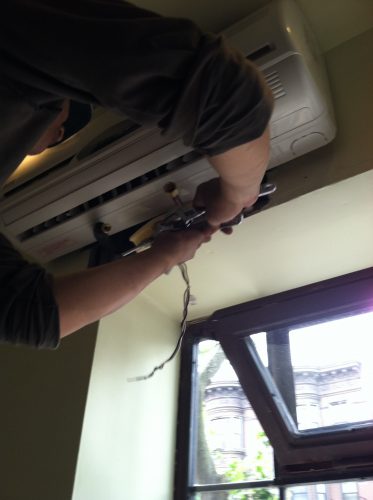
As a green contractor, Eco-Brooklyn loves split AC’s because they are extremely efficient, not energy intensive, and help reduce our customer’s carbon footprint. We have our own AC installer and have installed many split AC’s, both in normal houses and in the Passive House (in that case it was the only source of cooling and heating).
As of right now, green construction companies like Eco-Brooklyn are willing to pay the premium on split modal AC because of our belief in reducing our carbon and ecological footprint. We also like to think realistically about the future; global warming is currently upon us. It is only going to get hotter from here, so preparing for high energy costs and high temperature definitely seems like a good idea to us.

